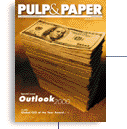|

Thomas H. Schmidt is President of the Wisconsin Paper Council
|

Regulatory system needs overhaul
Command and control—the traditional approach to environmental regulation in this country—is out-dated and in need of massive reform. Command and control was effective in past decades, and is still needed as a base or floor for environmental performance; however, the system is broke. Today, the paper industry and others are removing smaller and smaller amounts of pollutants at increasing costs. Diminishing returns have set in. In addition, the U.S. Environmental Protection Agency (EPA) and its state counterparts continue to regulate on a pollutant-by-pollutant basis over the short term. This is not cost-effective.
The command and control approach also fosters an adversarial relationship between the public and private sectors. This situation, too, is counter-productive. Compounding the problem is the fact that resources—both financial and manpower—in both the public and private sectors—are scarce.
We’ve reached the point where we must find a new and better way to both protect and/or improve the environment while assuring a healthy and vigorous economy in an intensely competitive global marketplace. Thankfully, both business and government leaders are coming to the realization that the system is broke and needs fixing.
Recently a delegation of government and business leaders from Wisconsin traveled to Europe to study regulatory reform that is underway in Germany and the Netherlands. Participants included Deptartment of Natural Resources (DNR) Secretary George Meyer and key agency staff; University of Wisconsin staff; and representatives of the paper and utility industries. I was fortunate to participate in this informative and thought-provoking study trip. Our host “states,”—the Free State of Bavaria and the Province of Gelderland—are two of the most aggressive and progressive states in the world in terms of environmental regulation and regulatory reform.
Both governments are utilizing pacts or covenants between government and industry which feature a long-term focus, increased responsibility and self-determination on part of the business community, and a government that steps back. The process is one of cooperation, consensus, and mutual trust. In each country, the pacts are sector or industry-wide and voluntary. However, non-participants, or poor performers, are subject to more stringent case-by-case regulations and sanctions.
It should also be noted that in Germany, both government and business leaders concede that there has not been a quid-pro-quo for industry assuming more responsibility. The environmental pact of Bavaria has been in place four years, yet the government has not fulfilled its commitments to the private sector.
A key concept of the regulatory reform movement in both countries is self-determination, a realization that the private sector, not government, is best suited to determine how to cost-effectively manage its behavior. In both countries, the government affords industry the flexibility to determine how to meet its environmental objectives and responsibilities. Similarly, both government and business take a more holistic approach toward the environment. The focus, contrary to that in the U.S., is on major issues, not on a pollutant-by-pollutant basis. This affords the private sector with the opportunity to plan its capital expenditures over a longer timeframe (10 to 15 years) rather than the short-term (five years) and helps assure a bigger “bang-for-the-buck” in terms of environmental improvement.
The regulatory reform movement in The Netherlands is a relatively new phenomenon. Faced with a declining economy during the late 1980s, a coalition of government, business and labor developed what is called the “Poldermodel” of self-determination. This historical perspective brings me to a key point—economics are integrated into all environmental and policy decisions in both Bavaria and the Netherlands. We heard this message repeatedly from both government and business leaders. This is a striking difference in how public policy, specifically environmental policy, is developed in this country and in Wisconsin. It’s unfortunate EPA officials didn’t hear this important message firsthand.
The European community is recognizing the shortcomings of the traditional command-and-control approach and is taking positive steps to reform the system. It is important to recognize that the European approach is not perfect, and that not all elements of the regulatory reform movement are or should be applicable to the U.S. or even to Wisconsin. However, key concepts, principles and approaches are plausible and deserve serious consideration, namely: consensus-building, self-determination, and cost-effectiveness.
It’s time for the U.S. and Wisconsin to move forward with regulatory reform. It won’t be easy as it requires changing mind-sets in both the private and public sectors. Reform is absolutely essential, however, if the U.S. paper industry is to remain economically competitive in a global marketplace.

|





